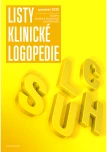NARRATIVE DISCOURSE IN BROCA‘S AND ANOMIC APHASIA
Authors:
Mgr. Kevická Viktória 1; doc. PaedDr. Marková Jana; PhD. 1; Mgr. Gavalerová Mária 2
Authors‘ workplace:
Katedra logopédie, Pedagogická fakulta Univerzity Komenského v Bratislave
1; Neurologická klinika Univerzitnej nemocnice L. Pasteura v Košiciach
2
Published in:
Listy klinické logopedie 2020; 4(2): 113-123
Category:
Miscellaneous
Overview
In patients with aphasia, there are various language deficits, which are also manifested at the level of discourse. The aim of the research was to describe the discourse of patients with Broca’s aphasia and anomic aphasia and to compare their discourses with the discourses of the control groups of the same age, education and gender. The research sample consisted of 34 respondents: 7 patients with Broca’s aphasia, 10 patients with anomic aphasia and 17 intact people in the control groups. Discourse samples were elicited, using the narration of the Cinderella story. Discourse analysis focused on three basic areas: productivity and fluency, errors and corrections, cohesion and informativeness. The performances of patients with Broca’s and anomic aphasia were significantly weaker in all three analysed areas than the performances of the control groups.
Keywords:
Broca’s aphasia – anomic aphasia – narrative discourse – discourse analysis
Sources
- ANDREETTA, S., CANTAGALLO, A., MARINI, A., 2012. Narrative discourse in anomic aphasia. Neuropsychologia. Vol. 50, 2012, s. 1787-1793.
- ANDREETTA, S., MARINI, A., 2014. Narrative assessment in patients with communicative disorders. Travaux neuchoatelois de linguistique. Vol. 60, 2014, s. 69-84.
- ARDILA, A., 2014. Aphasia Handbook. USA: Florida International University.
- ASH, S. et al., 2011. The organization of narrative discourse in Lewy body spectrum disorder. Brain & Language. Vol.119, 2011, s. 30-41.
- BROOKSHIRE, R. H., 2015. Introduction to neurogenic communication disorders. USA: Elsevier. ISBN 978-0-323-07867-2.
- CLARK, H. H., 2014. Spontaneous discourse. In: GOLDRICK, M., FERREIRA, V., MIOZZO, M. The Oxford Hanbook of Language Production. New York: Oxford University Press. s. 292-307. ISBN 978-0-19-973547-1.
- CODE, CH., HERRMANN, M., 2003. The relevance of emotional and psychosocial factors in aphasia to rehabilitation. Neuropsychological rehabilitation. 13(1/2), s. 109-132.
- COLEMAN, C., 2013. How can you tell if childhood stuttering is the real deal? Dostupné na: http://blog.asha.org/2013/09/26/how-can-you-tell-if-childhood-stuttering-is-the-real-deal/
- CSÉFALVAY, Zs., 2007. Klinické syndromy afázie. In: CSÉFALVAY Zs. a kol. Terapie afázie. Praha: Portál, 2013. ISBN 978-80-7367-316-1.
- CSÉFALVAY, Zs. 2016. Afázia. In KEREKRÉTIOVÁ, A. et al.: Logopédia. Bratislava: UK, s. 231-248. ISBN 978-80-223-4165-3.
- DIJKSTRA, K. et al., 2004. Conversational coherence: Discourse analysis of older adults with and without dementia. Journal of Neurolinguistics. Vol.17, 2004, s. 263-283.
- DOLNÍK, J., BAJZÍKOVÁ, E., 1998. Textová lingvistika. Bratislava: Stimul. ISBN 80-85697-78-5.
- DOOLEY, R. A., LEVINSOHN, S. H., 2001. Analyzing discourse. A manual of basic concepts. Dallas: SIL International. ISBN 1-55671-115-8.
- ELLIS, CH. et al. 2015. Narrative discourse cohesion in early stage Parkinson‘s disease. Journal of Parkinson‘s disease. Vol. 5, s. 403-411.
- FERGADIOTIS, G., WRIGHT, H. H., WEST, T. M., 2013. Measuring lexical diversity in narrative discourse of people with aphasia. American Journal of Speech-Language Pathology. 22(2).
- FINDRA, J., 2012. Vymedzenie niektorých základných pojmov a termínov textovej lingvistiky. Slovenská reč. Roč. 77, 2012, č. 1–2, s. 40-47.
- KAVÉ, G., LEVY, Y., 2003. Morphology in picture description provided by persons with Alzheimer‘s disease. Journal of Speech, Language and Hearing Research. V. 46, s. 341-352.
- KEVICKÁ, V., 2019. Jazykové deficity v orálnom diskurze pacientov s neurogénnymi poruchami komunikácie. In: Logopaedica 21(1), s. 29-35.
- KOHN, S. E., 1972. Phonological production deficits in aphasia. In: WHITAKER, H. A. Phonological Processes and Brain Mechanisms. New York: Springer-Verlag. ISBN 978-1-4615-7581-8.
- KONG, A. P. H., 2016. Analysis of neurogenic disordered discourse production. From theory to practice. New York: Routledge. ISBN 978-1-138-85358-4.
- LIMA, T. M. et al., 2014. Alzheimer’s disease: cognition and picture-based narrative discourse. CEFAC. |Vol. 16, 2014. no. 4, s. 1168-1176.
- MARKOVÁ, J., 2008. Analýza spontánnej reči u pacientov s afáziou. Efeta. 18(1), 2008, s. 2-6.
- MARKOVÁ, J., CSÉFALVAY, Zs., 2010. Morphological-syntactic deficits in the production of Slovak-speaking aphasic patients. Aphasiology. 24(10), 2010.
- MACWHINNEY, B. et al., 2010. Automated analysis of the Cinderella story. Aphasiology, 24(6-8), s. 856-868.
- MISTRÍK, J., 1989. Štylistika. Bratislava: Slovenské pedagogické nakladateľstvo.
- NICHOLAS, E. L., BROOKSHIRE, R. H., 1993. A system for quantifying the informativeness and efficiency of the connected speech of adults with aphasia. Journal of Speech and Hearing Research. Vol. 36, 1993, s. 338-350.
- ORAVEC, J., BAJZÍKOVÁ, E., 1982. Súčasný slovenský spisovný jazyk. Syntax. Bratislava: SPN.
- PEARSON, B., DEVILLIERS, P., 2006. Discourse, narrative and pragmatic development. In: BROWN, K. Encyclopedia of Language & Linguistics. 2. vyd. Amsterdam: Elsevier. ISBN 978-0-08-044854-1.
- STARK, B. C., 2019. A comparison of three discourse elicitation methods in aphasia and age-matched adults: Implications for language assessment and outcome. American Journal of Speech-Language Pathology. 28(3).
- ZHANG, M. et al., 2020. Cohesion in the discourse of people with post-stroke aphasia. Clinical Linguistics & Phonetics. DOI: 10.1080/02699206.2020.1734864.
Labels
Clinical speech therapy General practitioner for children and adolescentsArticle was published in
Clinical speech therapy (Listy klinické logopedie)

2020 Issue 2
Most read in this issue
- CASE STUDY OF BOY WITH SUBMUCOSAL CLEFT PALATE, DEVELOPMENTAL DYSPHASIA AND EATING DISORDER
- PHONEME AWARENESS, READING AND EARLY INTERVENTION IN CHILDREN WITH HEARING IMPAIRMENTS
- DIAGNOSTICS OF NARRATIVE ABILITIES AND CZECH ADAPTATION OF THE MAIN TOOL
- HEARING EXAMINATION WITH METHODS OF EVOKED POTENTIALS AND ITS LIMITATIONS IN THE YOUNGEST CHILDREN
